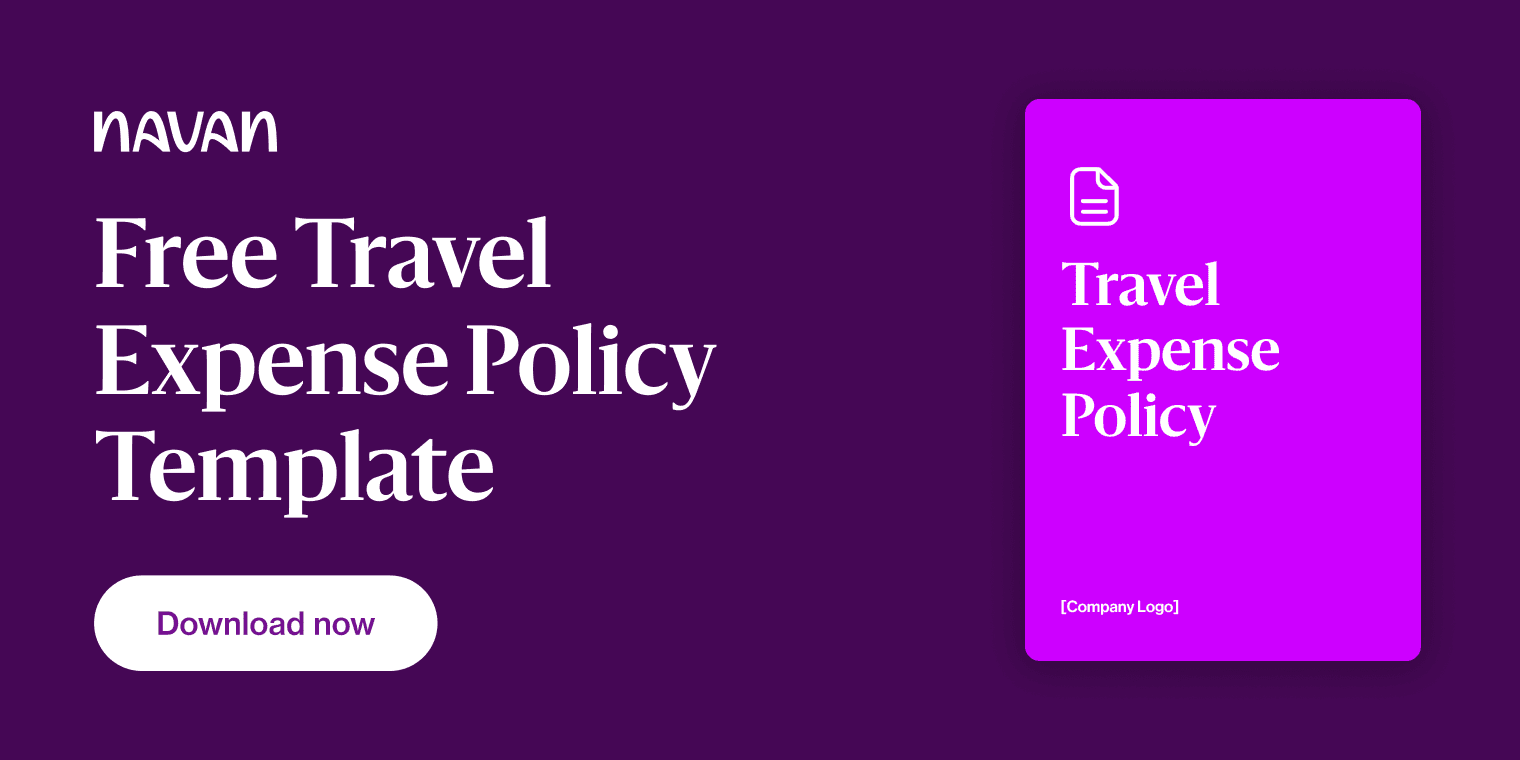What Are Travel and Expense Policies?

Business expenses can fuel your company’s growth or drain resources faster than a red-eye flight. That’s where travel and expense (T&E) policies come in. These dynamic guidelines help streamline operations, foster transparency, and keep everyone on the same page.
This guide will explain exactly what a T&E policy is, why it’s essential, and how it can help businesses stay on budget while keeping employees confident and productive.
What is a Travel and Expense Policy?
A travel and expense policy is a dynamic set of guidelines companies create, enforce, and consistently refine to guide employees on business-related travel costs and other expenses. Because every company is unique in its needs and expectations, business travel and expense policies will look and act differently for every organization.
These policy guidelines can include budgets for flights and lodging, how to receive reimbursement for travel expenses, allowable spend for business-related expenses like subscriptions or stipends, or anything in between. In some policies, companies may incorporate preferred airlines and vendors, directions on submitting expense reports, and guidelines for bleisure travel.
Whatever the policy’s scope, a clear-cut system can manage costs effectively, allowing employees to travel and spend confidently.
Why Companies Create Dynamic Travel And Expense Policies
Rather than scrambling for receipts when employees return from a sales trip or leaving them in the dark while waiting for reimbursements, a dynamic T&E policy can alleviate pain points along the entire expense management journey.
When financial leaders set clear guidelines for employee expenses, users reap the benefits of:
- A fluid and working expense threshold that changes with a business ecosystem
- Complete control and transparency of business expenses
- A reduction in expense errors
- Streamlined workflows for booking travel and spending for business purposes
- Increased productivity
- Peace of mind when employees spend company money
What Happens Without a T&E Policy?
Without a travel and expense policy, employees may spend at their own pace — costing the company unnecessary dollars — or they may miss out on potentially beneficial business purchases for fear of overspending. When lacking a T&E policy, financial teams may experience poor data visibility; they might miss errors, potential fraud, and duplicate reports.
Expense reports may arrive late or without essential information since employees aren’t aware of specific guidelines. Other employees may be looking for reimbursement for items that don’t fit a company’s expense categories.
What to include in a travel and expense policy
There’s no one-size-fits-all expense-policy template. Financial leaders should ask themselves what their specific organization needs are from a control and spend perspective.
Some questions to ask may be:
- What are considered reimbursable expenses?
- What are personal expenses?
- What is the per diem for different teams? Different departments? Different leaders?
- What are the budgets surrounding airfare, hotels, rental cars, and business meals?
Employees may also be curious about whether they are allowed seat upgrades or business class options, whether they can use their corporate cards with certain retailers, or whether they can receive points or rewards with certain carriers. Employees must also understand what is non-refundable and how to document proof of purchase.
Define the Scope of a T&E policy
Companies can begin by determining if a policy covers all employees or specific teams. Organizations should consider full-time, part-time, and contract employees as well. Who will need to spend management around office supplies, entertainment expenses, and sponsored projects may vary significantly.
Transportation and Lodging Accommodations
- Rental cars
- Rideshares
- Taxis
- Public transport
- Upgrades
- Preferred airlines
- Flight costs
- Travel perks (rewards, lounges, etc.)
- Blesiure
- Preferred hotels
- Maximum star ratings
- Reimbursable incidentals
- Room types (suites, deluxe, standard, etc.)
Work-related Expenses and Per Diems
With a business expense policy in place and per diems and quarterly budgets set, companies can help teams thrive while keeping finances in check. To do so, leaders should set policies around:
- Personal expenses vs. business expenses
- Stipends for wellness, working from home, or mental health resources
- Business licenses or subscriptions
- Continuing education
- Per diems for travel
- Entertainment opportunities for teams and customers
Expense Reimbursement Policy
- Types of expenses that may be reimbursable
- Mileage reimbursement
- Handling reimbursement requests
- Reimbursement turnaround times
The bottom line is to always consider the business traveler. While finance, HR, and operations may be involved in writing the policy, it’s the employees who will be spending. Be sure they can understand what’s in it.
Enforcing Policies with Technology
Here’s where the magic happens: automation. With technological tools, companies can bring their policies to life with built-in controls and real-time updates.
- Automated Compliance: Expenses outside the policy? They get flagged instantly.
- Streamlined Reporting: Employees submit receipts digitally, eliminating paperwork chaos.
- Integrated Workflows: Corporate cards and booking platforms sync seamlessly, simplifying approvals and reimbursements.
- Real-time visibility ensures leaders can make budgetary decisions on the fly, backed by accurate data.
Why Automation Is Non-Negotiable
As businesses grow, so do their spending complexities. Scaling successfully means leveraging technology that grows with you.
Modern tools like Navan
With automation, employees can focus on their work while finance teams keep costs under control. It’s a win-win.
Ready to Take Control of T&E Management?
As companies scale, the technology behind their travel and expense policy should scale with them. With Navan Expense, the policy is baked into corporate travel booking. Users can easily see which hotels, cars, and flights are within their limits and manage them throughout the entire trip.
Whether on a business trip, working from home, or going into the local office, team members can get pre-approval for expenses within their policy for automatic reconciliation and reimbursements. Employees can easily spend what’s necessary to benefit the company, and leaders can feel confident their policies are controlling costs.
Whether you’re managing a startup or a growing enterprise, a well-crafted T&E policy backed by powerful tools like Navan Expense can transform expense management from a hassle into a seamless process. Get started today.
This content is for informational purposes only. It doesn't necessarily reflect the views of Navan and should not be construed as legal, tax, benefits, financial, accounting, or other advice. If you need specific advice for your business, please consult with an expert, as rules and regulations change regularly.


